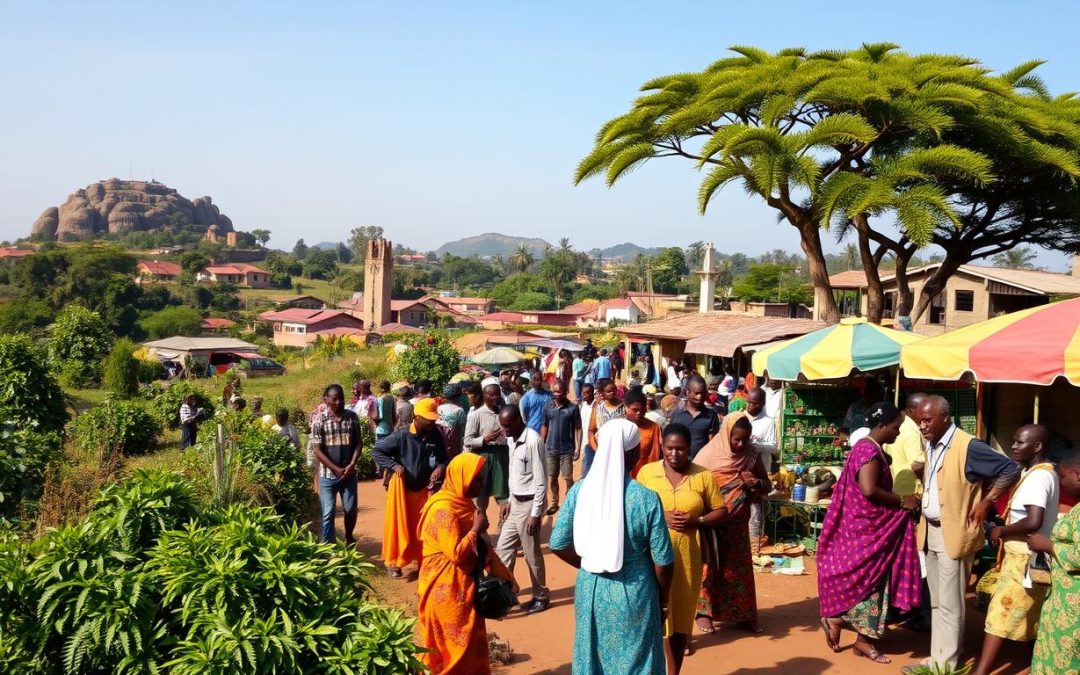Did you know that Guinea, a West African nation, has over 40 distinct languages? Each language tells a unique story of cultural heritage and history. Welcome to Guinea, where language is a vibrant tapestry that challenges our understanding of communication!
Guinea’s language scene is a colorful mix of indigenous tongues and colonial influences. French is the official language, showing off the country’s rich cultural roots and complex history.
In Guinea, languages are more than just a way to talk. They are stories of identity, tradition, and social ties. The country’s many languages come from different ethnic groups, creating a unique communication world.
Key Takeaways
- Guinea speaks over 40 different languages
- French remains the official administrative language
- Fula is the most widely spoken indigenous language
- Linguistic diversity reflects Guinea’s complex cultural heritage
- Four major geographic regions correspond to specific language groups
- Language distribution varies significantly across different regions
- Multilingualism is a standard feature of Guinean society
Overview of Guinea’s Linguistic Landscape
Guinea is a vibrant mix of languages, each telling a part of its rich culture. The country’s language scene is shaped by history, society, and geography. This mix creates a unique way of talking across different areas.
In West Africa, Guinea has a diverse language heritage. It has about 24 languages, showing its complex culture. This diversity makes Guinea’s language scene truly special.
The Evolution of Language in Guinea
Guinea’s language history is long and complex. The country’s past, from before colonial times to now, has shaped its languages. This mix of old and new languages is unique.
- Indigenous languages came from different ethnic groups
- French became official during colonial times
- Old ways of talking changed with new languages
Current Language Demographics
Guinea’s language spread is interesting:
| Language | Percentage of Speakers | Region Concentration |
|---|---|---|
| Susu | 30% | Coastal Regions |
| Mandinka | 25% | Eastern Guinea |
| Pulaar | 20% | Northern Regions |
| Other Languages | 25% | Various Regions |
Linguistic Distribution Across Regions
In Guinea, language use changes a lot between cities and countryside. French is key in work and school, but local languages keep cultural ties strong in villages.
“Language is the roadmap of a culture. It tells you where its people come from and where they are going.” – Rita Mae Brown
Guinea’s language diversity shows a lively scene where many languages live together. Each one tells a story of culture and history.
French: The Official Language of Guinea
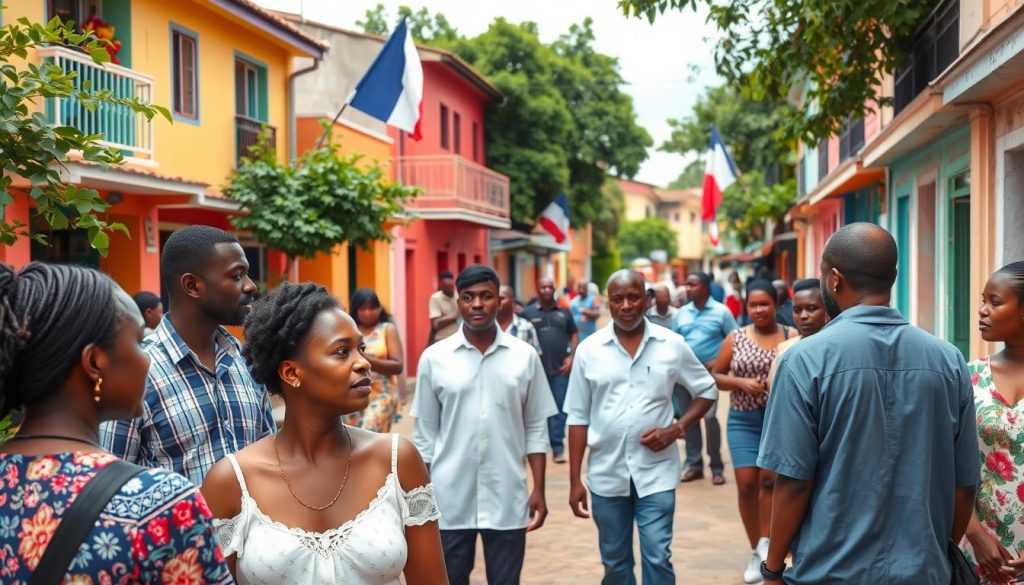
French is the key official language in Guinea. It’s used in government, schools, and businesses. Even though only 15-25% of people speak it as their second language, it’s very important for talking to each other.
The history of French in Guinea goes back to the colonial days. France ruled then, and French became a big part of the country’s way of talking.
*”Language is the road map of a culture. It tells you where its people come from and where they are going.”* – Rita Mae Brown
Here are some key things about French in Guinea:
- It’s the main language of government.
- It’s used a lot in schools.
- It’s key for official papers.
- It’s very important for work and professional talks.
In cities like Conakry, people speak French better than in the countryside. French helps connect different ethnic groups in this country.
| Language Metric | French in Guinea |
|---|---|
| Second Language Speakers | 15-25% of population |
| Urban Proficiency | Higher than rural areas |
| Official Status | Primary administrative language |
| Educational Use | Primary language of instruction |
Learning about Guinea’s languages shows us that French is more than just a way to talk. It’s a key part of keeping the country together and helping people communicate.
National Languages of Guinea
Guinea’s language scene is rich and diverse. It’s filled with many indigenous languages that help keep culture alive. The country has many national languages that show its ethnic diversity and history.
The government has picked six main national languages. These languages show the country’s rich linguistic variety:
- Fula (Pular)
- Malinké (Maninka)
- Susu
- Kissi
- Kpelle
- Loma
Historical Recognition Process
These West Atlantic languages got official status through a careful process. It was all about keeping culture alive and uniting the nation. The goal was to protect these languages and keep them used in Guinea’s different areas.
Cultural Significance
Each national language is tied to a specific ethnic group’s culture. They are key for keeping traditions, stories, and social bonds alive.
| Language | Percentage of Speakers | Primary Regions |
|---|---|---|
| Fula | 40% | Fouta Djallon Highlands |
| Malinké | 30% | Upper Guinea |
| Susu | 20% | Maritime Guinea |
| Kissi | 3.5% | Forest Region |
Official Status and Implementation
Even though French is the official language, these national languages are becoming more important. They are being used more in schools, local government, and media. The aim is to make Guinea’s language scene more inclusive and respect its rich cultural heritage.
Language is the road map of a culture. It tells you where its people come from and where they are going. – Rita Mae Brown
Pular (Fula) Language: The Most Spoken Indigenous Language
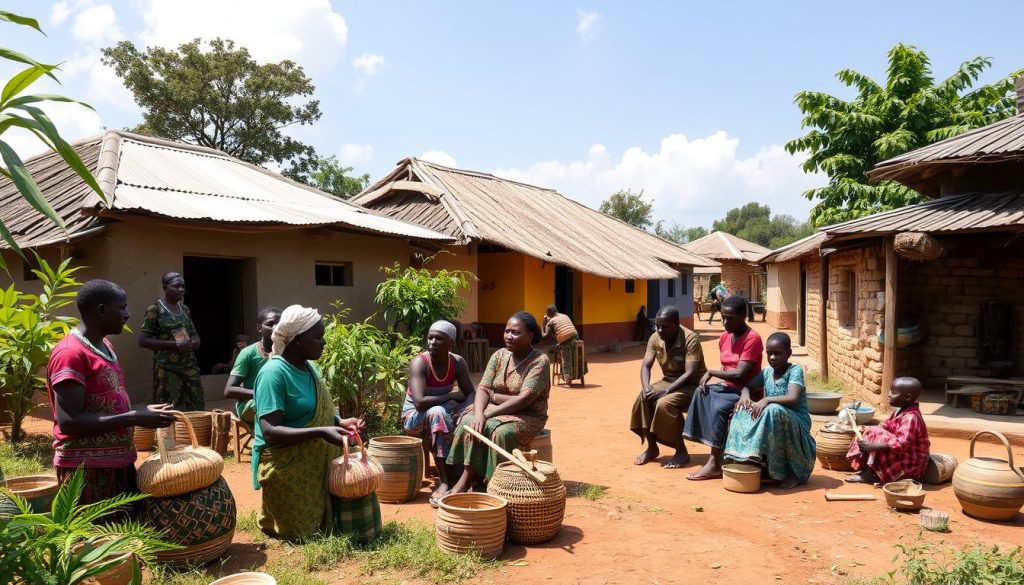
Pular is a vibrant language in Guinea, loved by many. It has about 4.3 million speakers. This makes it a key part of Guinea’s culture.
In the Middle Guinea region, especially in Labé and Mamou, Pular brings people together. It connects communities through rich traditions.
Pular is a powerful tool for communication in Guinea. It is written in several scripts, including:
- Adlam (modern script created in late 1980s)
- Ajami (traditional rural script)
- Latin script
“Pular is more than a language; it’s a bridge connecting communities across West Africa.” – Language Researchers
Exploring Pular shows interesting facts. In Labé, 94.5% of people speak it. Mamou has 92.4%. These numbers highlight the language’s deep cultural value.
| Region | Pular Speakers | Percentage |
|---|---|---|
| Labé | 94.5% | Highest Concentration |
| Mamou | 92.4% | Strong Presence |
| Conakry | 42% | Significant Urban Representation |
Learning about Pular shows its importance. It’s not just for talking. It’s also key for social life, business, and keeping culture alive in Guinea’s diverse communities.
Maninka: Heritage of the Mali Empire
Explore the rich world of Maninka, an indigenous language in Guinea. It’s deeply connected to the Mali Empire’s history. With about 2.1 million speakers, Maninka is a key part of Guinea’s language diversity.
The Maninka language holds deep cultural value, especially in Upper Guinea. Its ties to the Mali Empire show its importance beyond just talking.
Historical Roots and Cultural Significance
Maninka comes from the Mandé people, a vibrant group in West Africa. Its story shows the area’s social and cultural changes.
- Connected to the historical Mali Empire
- Spoken by approximately 2 million individuals
- Part of the broader Mandé language family
Contemporary Language Usage
Today, Maninka is still important in Guinea. It’s used in everyday talk, culture, and community life. Its strength shows the lasting impact of indigenous languages.
The N’Ko Writing System
In 1949, Solomana Kante created the N’Ko writing system. It’s a special alphabet for Manding languages like Maninka. This innovation has helped with literacy and keeping culture alive.
“Language is the roadmap of a culture. It tells you where its people come from and where they are going.” – Rita Mae Brown
The N’Ko script is more than a writing system. It’s a symbol of cultural identity and pride for Maninka speakers.
Susu: The Language of Maritime Guinea
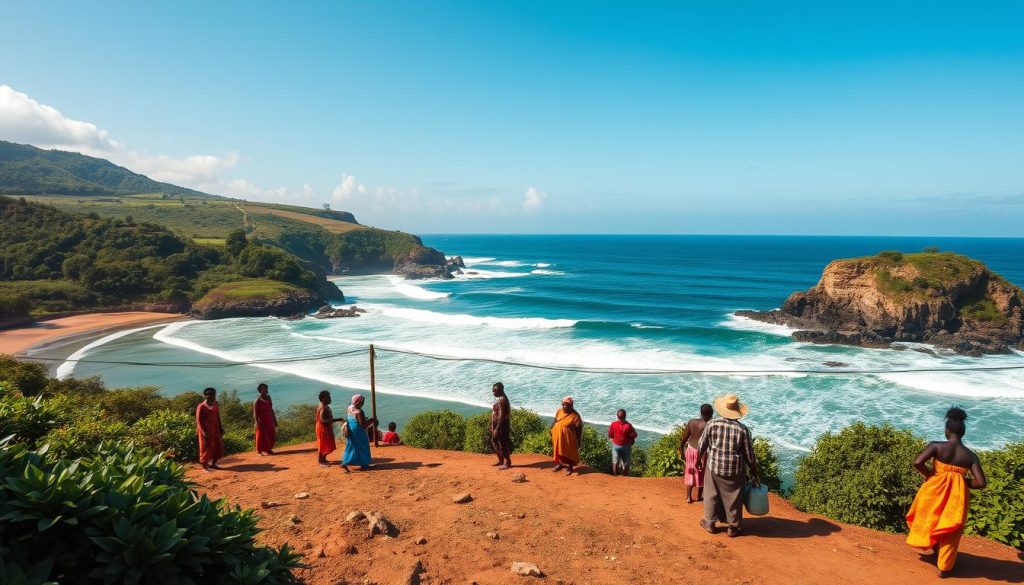
Explore the lively world of Susu, a key language in Maritime Guinea. It’s the third most spoken indigenous language in the country. Susu is vital in the coastal areas, especially in Conakry and the Kindia Region.
The Susu language shows the rich culture of Guinea. It’s big in urban life and business. In Conakry, about 37% of people speak Susu, making it a big deal in the capital.
- Dominates the Kindia Region with 54.9% of population speakers
- Represents 17.7% of Guinea’s total language demographics
- Crucial for communication in Maritime Guinea’s coastal areas
Susu is part of the Mande language family. It shows deep ties with other languages in the area. It’s more than just talking; it’s a key part of cultural and economic ties.
“Susu is more than a language – it’s the voice of Maritime Guinea’s cultural identity.”
Susu is flexible and widely used. It’s key to understanding social life in Guinea’s coastal areas. It’s used in markets, schools, and community events. Susu lets the Guinean people express themselves powerfully.
Guinea: Official and Widely Spoken Languages
Guinea’s language scene is rich and diverse, showing off the country’s varied cultures. Knowing about the languages helps us see how Guineans connect and keep their culture alive.
Language Policy Framework
Guinea values many languages but French is the main official one. The government sees national languages as key to keeping culture strong and making everyone feel included.
- French is the main official language
- Many national languages are officially recognized
- The government supports using many languages
Statistical Distribution
Guinea’s languages show a lot of variety. Here’s a look at how common each language is:
| Language | Percentage of Population | Primary Region |
|---|---|---|
| Pular (Fula) | 40% | Middle Guinea |
| Malinké | 30% | Middle Guinea |
| Susu | 20% | Coastal Regions |
| Other Languages | 10% | Various Regions |
Regional Variations
Language use changes a lot in different parts of Guinea. Each group’s language is important for daily life and keeping culture alive.
“Language is the road map of a culture. It tells you where its people come from and where they are going.” – Rita Mae Brown
Learning about Guinea’s languages helps us understand the complex ways people communicate there.
Minor National Languages: Kissi, Kpelle, and Toma
Guinea’s language scene is rich and varied, showing off the country’s diverse culture. The Kissi, Kpelle, and Toma languages are key parts of this. They belong to the West Atlantic language family.
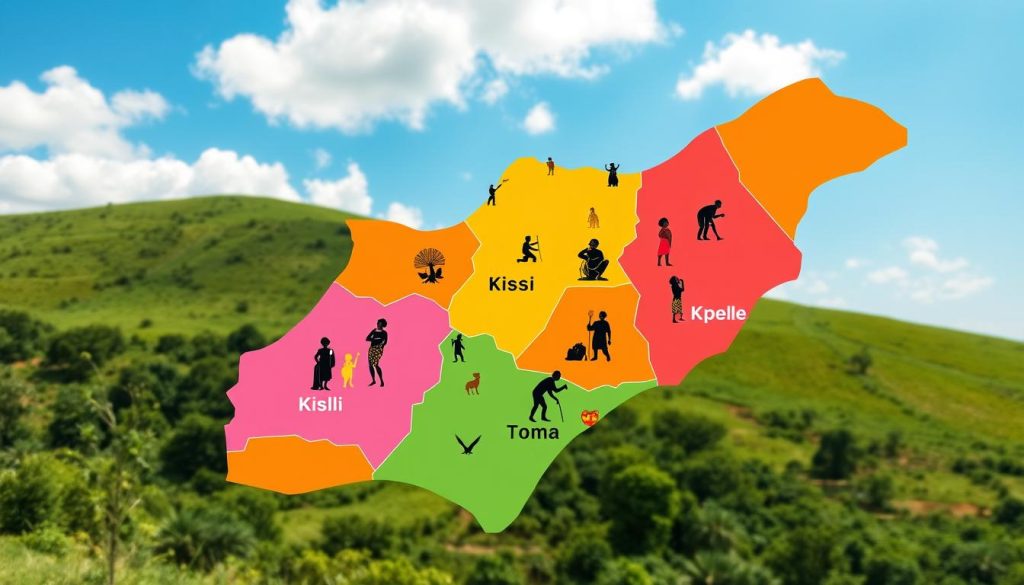
The Kissi language is found in southeastern Guinea, especially in Guéckédou and Kissidougou. Its speakers keep their cultural traditions alive. They pass down stories and customs from one generation to the next.
- Kissi: Primarily spoken in southeastern Guinea
- Geographic concentration: Guéckédou and Kissidougou regions
- Cultural significance: Important for local identity preservation
Kpelle is another important language in Guinea. It’s part of the West Atlantic language family. It helps keep the region’s cultural diversity alive. Most Kpelle speakers live in southern Guinea’s forest areas.
“Language is the road map of a culture. It tells you where its people come from and where they are going.” – Rita Mae Brown
| Language | Primary Region | Estimated Speakers |
|---|---|---|
| Kissi | Southeastern Guinea | Approximately 50,000-100,000 |
| Kpelle | Southern Forest Regions | Around 70,000-120,000 |
| Toma | Mountainous Western Areas | Roughly 40,000-80,000 |
The Toma language is also vital, though often overlooked. It’s spoken in western Guinea’s mountains. Toma adds to Guinea’s rich language diversity.
These languages show Guinea’s dedication to saving its language heritage. They ensure that even smaller language groups can keep their culture alive.
Urban vs Rural Language Distribution
Guinea’s language scene shows interesting differences between cities and countryside. In places like Conakry, many languages mix together. Here, indigenous tongues blend with French and local dialects.
The way languages are spread out changes a lot between cities and rural areas:
- Urban spots have 14 different languages on average per community
- Rural places usually see about 8 indigenous languages
- People moving around affects how languages meet and mix
Urban growth has changed how languages work in Guinea. Cities are now places where many languages come together. This creates special ways of talking and understanding each other.
| Location Type | Average Languages Spoken | Primary Communication Patterns |
|---|---|---|
| Urban Areas | 14 languages | Multilingual interactions |
| Rural Areas | 8 languages | More homogeneous communication |
“Language is the roadmap of a culture. It tells you where its people come from and where they are going.” – Rita Mae Brown
Knowing about these language differences helps us see Guinea’s rich culture. Each language offers a special view into the country’s varied social world. It connects old traditions with new ways of talking.
Language in Education and Public Services
Guinea’s language scene is complex. It needs a smart plan for education and public talks. The country’s many languages bring both problems and chances for using languages well in key areas.
Educational System Language Policy
French is the main language in schools in Guinea. Knowing about the country’s language policy shows a mix of views on language variety:
- French is the official language in schools
- National languages start to appear in early classes
- Teachers are learning to teach in many languages
Government Communication Strategies
The government of Guinea works hard to deal with language variety. They use many ways to communicate:
- They translate government documents into many languages
- They offer interpreter services for local languages
- They run special talks in local languages
Media Broadcasting Languages
Media is key in showing off language variety. In Guinea, media usually:
| Language | Media Platforms | Reach |
|---|---|---|
| French | National TV, Radio | Nationwide |
| Pular | Regional Radio | Futa Jallon Region |
| Susu | Local Broadcasts | Maritime Guinea |
| Maninka | Community Radio | Upper Guinea |
“Language is the road map of a culture. It tells you where its people come from and where they are going.” – Rita Mae Brown
Looking into Guinea’s language diversity shows a careful balance. They mix official languages with the local language heritage in public services.
Conclusion
Your journey through Guinea’s language world shows a rich cultural heritage. The official and national languages are more than just ways to talk. They are alive, showing the country’s varied cultural identity.
French is the official language, but indigenous languages like Pular, Maninka, and Susu add color to the story. They reflect Guinea’s long history.
Linguistic diversity in Guinea is more than talking. Each language holds stories, traditions, and social bonds. The mix of official and national languages shows Guinea’s effort to keep culture alive while uniting the nation.
This balance lets local communities keep their unique languages. At the same time, they join in national talks.
Learning about Guinea’s languages gives deep insights into multilingual societies. You see how language helps keep culture alive, brings people together, and unites the nation. Guinea’s language scene keeps changing, facing new challenges while staying true to its traditions.
Your understanding of Guinea’s languages shows how important language is in culture and society. The way Guinea handles its languages is a great example. It shows how languages can live together, interact, and shape a nation’s story.
The above is subject to change.
Check back often to TRAVEL.COM for the latest travel tips and deals.
